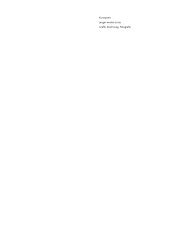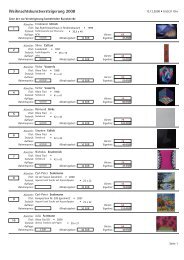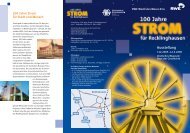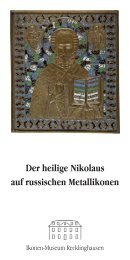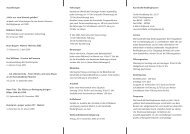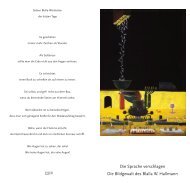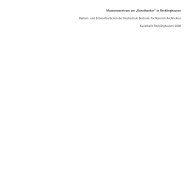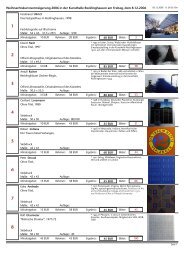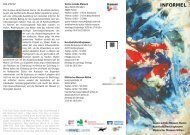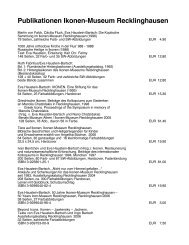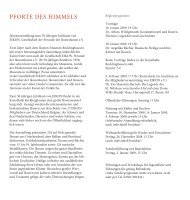The Myth of Palekh â Icons and Lacquer Miniatures - Kunsthalle ...
The Myth of Palekh â Icons and Lacquer Miniatures - Kunsthalle ...
The Myth of Palekh â Icons and Lacquer Miniatures - Kunsthalle ...
Create successful ePaper yourself
Turn your PDF publications into a flip-book with our unique Google optimized e-Paper software.
<strong>The</strong> <strong>Myth</strong> <strong>of</strong> <strong>Palekh</strong> – <strong>Icons</strong> <strong>and</strong> <strong>Lacquer</strong><br />
<strong>Miniatures</strong><br />
Exhibition at the <strong>Kunsthalle</strong> Recklinghausen<br />
December 12 th 2010 – February 6 th 2011<br />
<strong>The</strong> Recklinghausen Icon Museum, opened in 1956, is the<br />
most important museum <strong>of</strong> Eastern church art outside the<br />
Orthodox countries. Well over a thous<strong>and</strong> icons, gold<br />
embroideries, miniatures <strong>and</strong> works in wood <strong>and</strong> metal<br />
from Russia, Greece <strong>and</strong> the Balkan countries give a<br />
comprehensive survey <strong>of</strong> the manifold subjects <strong>and</strong> the<br />
stylistic development <strong>of</strong> icon painting <strong>and</strong> applied art in<br />
the Christian East.<br />
<strong>The</strong> town <strong>of</strong> Recklinghausen lies in the Ruhr District <strong>and</strong><br />
is therefore part <strong>of</strong> the ‘European Capital <strong>of</strong> Culture<br />
Ruhr.2010’. As a special project <strong>of</strong> the town on this<br />
occasion, the Icon Museum is planning an exhibition. <strong>The</strong><br />
painters’ village <strong>of</strong> <strong>Palekh</strong>, situated three hundred kilometres<br />
to the north-east <strong>of</strong> Moscow, is the centre <strong>of</strong> the<br />
exhibition. Art lovers associate two special types <strong>of</strong><br />
Russian art with the name <strong>of</strong> <strong>Palekh</strong>: exclusive, exquisitely<br />
detailed painted icons <strong>and</strong> the equally delicately executed<br />
lacquer miniatures on papier-mâché.<br />
<strong>The</strong> village <strong>of</strong> <strong>Palekh</strong> has been a centre <strong>of</strong> icon painting<br />
since the 17 th century. Influenced by the tradition <strong>of</strong> the<br />
Stroganov Style <strong>and</strong> the fresco <strong>and</strong> icon painting in the<br />
towns <strong>of</strong> the upper Volga area, the best artists <strong>of</strong> <strong>Palekh</strong><br />
developed the style known today as the ‘<strong>Palekh</strong> Style’.<br />
Typical attributes <strong>of</strong> the <strong>Palekh</strong> Style: In addition to the<br />
saints depicted on them, these <strong>Palekh</strong> icons also feature<br />
miniature architectural backdrops, delicately painted in<br />
pastel colours <strong>and</strong> richly decorated with white ornaments,<br />
as well as lush l<strong>and</strong>scapes, as equally important elements
<strong>of</strong> the composition. <strong>The</strong> painted area is <strong>of</strong>ten subdivided<br />
into a multitude <strong>of</strong> single little pictures where e.g the<br />
Feasts <strong>of</strong> the Christian Orthodox Liturgical Year or saints<br />
with their hagiographical scenes are shown in filigreed<br />
painting.<br />
<strong>The</strong> 1917 October Revolution resulted in a massive<br />
decline in dem<strong>and</strong> for icons, <strong>and</strong> the <strong>Palekh</strong> painters<br />
found their livelihoods threatened. In the early 1920s,<br />
some <strong>Palekh</strong> icon painters began to try their h<strong>and</strong>s at<br />
lacquer painting. In 1924, they founded the ‘<strong>Palekh</strong> Artel<br />
<strong>of</strong> Ancient Painting’ <strong>and</strong> began commercial production <strong>of</strong><br />
small objets d’art on papier-mâché, painted <strong>and</strong> lacquered<br />
using the egg tempera technique <strong>and</strong> gold. <strong>The</strong> artists,<br />
with their roots firmly anchored in the old tradition <strong>of</strong><br />
icon painting, had thus found a way to go on putting their<br />
artistic skills in fine art painting to good use under<br />
changed social conditions. Everyday rural scenes <strong>and</strong><br />
scenes from Russian fairy tales, from old Russian heroic<br />
epics <strong>and</strong> from Russian history were the principal<br />
subjects depicted on the lacquer works. In the 1930s, the<br />
artists also began to paint themes based on political<br />
ideology. <strong>The</strong>se depictions glamorised the social changes<br />
attributed to the October Revolution, <strong>and</strong> the glory <strong>of</strong> the<br />
Red Army in the civil war <strong>and</strong> later in the Second World<br />
War. <strong>The</strong> result was a symbiosis between the socialist<br />
realism promoted by the political system <strong>and</strong> stylistic<br />
elements from icon painting.<br />
Since the 1990s, icon painting has started up again in<br />
<strong>Palekh</strong>. Thus the circle is completed: from icon to lacquer<br />
miniature <strong>and</strong> back to the icon.<br />
<strong>The</strong> exhibition tries to duplicate this change. It will<br />
present icons, many <strong>of</strong> them from the rich collection <strong>of</strong><br />
the Recklinghausen Icon Museum, from the ‘Collezione<br />
Intesa Sanpaolo, Vicenza, Gallerie di Palazzo Leoni<br />
Montanari’, but also from private collections.<br />
Furthermore there will be shown magnificent examples <strong>of</strong><br />
lacquer miniatures from large collections in Switzerl<strong>and</strong><br />
<strong>and</strong> <strong>The</strong> Netherl<strong>and</strong>s; <strong>and</strong> last but not least icons painted<br />
in the last two decades.
<strong>The</strong> exhibition is meant for both specialists <strong>and</strong> a wider<br />
public, as the delicately painted icons <strong>and</strong> lacquer<br />
miniatures are a delight for the eye <strong>of</strong> every art lover!<br />
A detailed catalogue with scientific contributions will be<br />
published to accompany the exhibition.<br />
A meeting dedicated to the same topic will take place on<br />
January 22 nd at the Festspielhaus in Recklinghausen. In<br />
autumn a detailed program will be placed on the<br />
Museum’s homepage. Upon request, it can also be<br />
mailed.<br />
<strong>The</strong> curators <strong>of</strong> the exhibition:<br />
Dr. Eva Haustein-Bartsch, director <strong>of</strong> the<br />
Recklinghausen Icon Museum<br />
Dr. Felix Waechter, Switzerl<strong>and</strong><br />
<strong>The</strong> exhibition is staged in cooperation with<br />
the Münster Museum for <strong>Lacquer</strong> Art, which<br />
will present an exhibition ‘<strong>The</strong> School <strong>of</strong><br />
<strong>Palekh</strong> (1924 – 1950)’ from October 17 th 2010<br />
– February 13 th 2011.<br />
Address:<br />
<strong>Kunsthalle</strong> Recklinghausen<br />
Große-Perdekamp-Straße 25–27 (opposite the<br />
Central Station)<br />
D-45657 Recklinghausen<br />
Opening hours: Monday – Sunday 11–18 h,<br />
Wednesday 11–20 h<br />
Informations:<br />
Ikonen-Museum<br />
Tel. 0049-2361-501041<br />
Fax 0049-2361-501942<br />
E-mail: ikonen@kunst-re.de


